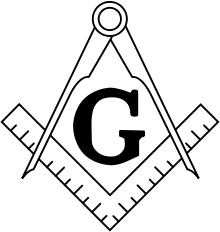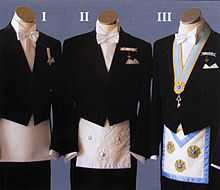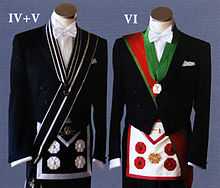Swedish Rite
| Part of a series on |
| Freemasonry |
|---|
 |
|
History
|
|
Masonic bodies
|
|
Views of Masonry |
|
People and places
|

The Swedish Rite is a variation or Rite of Freemasonry that is common in Scandinavian countries (and to a lesser extent in Germany). It is different from other branches of Freemasonry in that, rather than having three main degrees and seemingly-endless side degrees and appendant bodies, it has an integrated system with twelve main degrees. It is also different in that, rather than moving through the offices or 'chairs', progress in the Swedish Rite is based on moving through the twelve degrees. A more fundamental difference is the Swedish Rite's position on the continuum of religion: French Masonry is irreligious (no belief in a Creator is required), English Masonry is Deist, and Swedish Masonry is pointedly and specifically Christian. In spite of these radical differences from American or English Freemasonry, the Masons of the Swedish Rite (wherever it exists on the map) are considered equal to the Masons of the Emulation Rite as practiced in England, Scotland, or Canada.
The Swedish Rite is the default and usual Masonic rite in Sweden, Denmark, Norway, and Iceland; that is to say, when a man becomes a Mason in Sweden, Denmark, Norway, or Iceland, he invariably participates in the Swedish Rite. In Finland, the Grand Lodge of Sweden has several Swedish Rite lodges, but the native Grand Lodge of Finland works in standard Anglo-American tradition.
An interesting situation arises in Germany: there are five Grand Lodges with significantly different traditions. Rather than competing with each other for recognition by the United Grand Lodge of England, a superlodge known as the United Grand Lodges of Germany was formed, all of which is fully recognised. Unlike the UGLE, the constituent Grand Lodges of the UGLG have kept this divergence in tradition, meaning that any given medium-sized town will have any or all of the following: a British or Canadian lodge run by the American Canadian Grand Lodge or the Grand Lodge of British Freemasons in Germany, a standard German lodge run by the Grand National Mother Lodge, "The Three Globes" or the Grand Lodge of Ancient Free and Accepted Masons of Germany, and a Swedish Rite lodge run by the Grand Landlodge of the Freemasons of Germany.
Although fully independent, the Scandinavian Grand Lodges work closely together to keep their rituals as similar as possible.
Since 7 November 2006 all laws of the Swedish Order of Freemasons are publicly available on the Internet.[1] Among others, the laws prohibit any member to gain advantages outside the lodge by using the lodge as an instrument. The laws also stress the charity works of the members and the observance of the Golden Rule.
Membership
The Swedish Rite has approximately 16,500 members in the Swedish Obedience (of which 15,200 are in Sweden and 1,300 in Finland[2]), 2,800 in Iceland, and 16,700 in Norway.[3]
Members must be at least twenty-four years of age and of good repute; they must be recommended by at least two members, one of which must have at least the seventh degree and the other at least the third. The Swedish Rite is notably more selective than other Masonic traditions: acceptance rates are only approximately one in three.[4] The traditional rule that a candidate must come of his own will and accord is enforced within the Swedish Rite.
A final requirement is that the candidate profess to adhere to a mainstream Christian faith, assert that it is the best of all possible religions, and swear never to abandon it. If the Christian belief of the candidate is in doubt, a birth certificate may be requested; in the Scandinavian countries, birth certificates contain a field for religion. Neither The Church of Jesus Christ of Latter-day Saints (LDS Church), the Unification Church, nor the Jehovah's Witnesses are considered to be Christian denominations by the Swedish Rite;[5] beyond this, the Order does not admit a preference for any sect, whether Lutheran, Anglican, or Catholic.
Degrees



There are eleven (in Denmark, twelve) degrees in the Swedish Rite, grouped into four divisions: St John's degrees (equivalent to the Blue Lodge), St Andrew's degrees (equivalent to the Scottish Rite), Chapter degrees (equivalent to the Templar degrees), and a Grand Lodge degree. The four divisions are worked in separate lodge rooms, since the furniture, as well as the physical design, of the lodge is different between divisions.
- St. John's degrees
- I Apprentice
- II Fellow Craft
- III Master Mason
- St. Andrew's degrees
- IV/V Apprentice and Companion of St. Andrew (a double degree)
- VI Master of St. Andrew
- Chapter degrees
- VII Very Illustrious Brother, Knight of the East
- Novice (in Danish Order of Freemasons only)
- VIII Most Illustrious Brother, Knight of the West
- IX Enlightened Brother of St. John's Lodge
- X Very Enlightened Brother of St. Andrew's Lodge
- Grand Lodge degree
- XI Most Enlightened Brother, Knight Commander of the Red Cross
Most small-town lodge buildings will contain a St John's Lodge and likely also a St Andrew's Lodge. Only the various District Grand Lodges will contain a Chapter. In Sweden, Finland, and Iceland, Masons elevated to a degree higher than the third do not continue to be members of their old lodge; instead, a letter of introduction is written by the Lodge Secretary which enables the candidate to attend a St Andrew's Lodge of his choice, and pay dues thereto. This process is repeated when becoming a Knight of the East.
This presents a problem: because of the sometimes large distance between one's home and the closest St Andrew's Lodge, travel outlays can be excessive. To remedy this, Square-and-Compasses Clubs or Friendship Clubs were created in small towns so that St Andrew's or Chapter Freemasons can socialise without travelling inordinate distances. Friendship Clubs can not confer degrees, except with dispensation by Grand Lodge. In Denmark, Norway, and Germany, the problem is averted: St Andrew's and Chapter Masons continue to be members of Blue Lodge, but pay dues to all of their lodges.
The final degree of the Swedish Rite, that of Knight-Commander of the Red Cross, is given mostly to Grand Lodge officers, and it numbers approximately sixty members.[6] Beyond this, there is the only 'side degree' of the Swedish Rite---that of the Order of Charles XIII. This is an order of chivalry equivalent to a knighthood and given only to Knights-Commander of the Red Cross at the King's pleasure; its members may not number more than thirty-three, and three of them must be ecclesiastics of the established Lutheran Church. Although it is jokingly termed the 'twelfth degree', the Order of Charles XIII is in no way a part of the official Swedish Rite, and forms an invitation-only side degree or chivalric order.
The Masonic ring is given in the eighth degree, and consists of the customary red St Andrew's Cross and sometimes the Masonic motto, Veritas Persuadet. It is worn on the index finger of the right hand. A Knight of the West is also made to design his own coat of arms, taking the traditional European rules of heraldry into account. The resulting coat-of-arms hangs in his Provincial Grand Lodge.
The tenth degree is the highest ordinarily attainable; it can be received after roughly fifteen years of regular attendance and good proficiency in the ritual.
Organization and Officers
The officers of the lodges under the Swedish Rite are somewhat different from officers of Craft Masonry. The lodges are managed by a Worshipful Master, who will be assisted by one or more Deputy Masters (these are given Latin ordinal names: primary, secondary, and so forth). There are also the Primary and Secondary Wardens (similar to the Outer and Inner Guards), a Master of Ceremonies, a Secretary, a Treasurer, an Orator, a Master of Ceremonies, and a Director of Music.
The roles of officers do not rotate as in Anglo-American Freemasonry. Instead, the Master and his deputies, as well as the Wardens, are voted in; the other officers are appointed by the Master. Officers often keep their positions for many years at a time (in Sweden, they are limited to six years per term, and the retirement age is 75[7]). Deputy officers are fully empowered to take the place of their principals at stated meetings.
There are rules dictating minimum degrees for the various officers and their substitutes. In Denmark, the officers of a St John's lodge must uniformly be at least Master Masons; Wardens must be Knights of the East; and the Worshipful Master must be (depending on source) a Knight of the West[8] or a Right Enlightened Brother of St Andrew.
There is no obligation or expectation that a Mason will take up an office in the Swedish Rite; similarly, there is no progression between the offices. Any man holding the appropriate degree may campaign for election as Worshipful Master without ever having held any office before, and the same holds for all the other offices of the Rite.
Ritual
There is a single progression through the degrees of the Swedish Rite, as opposed to the multiple side degrees and appendant bodies of Anglo-American Masonry. Swedish Rite Masons join at the level of an Entered Apprentice, and, with time, become Right Enlightened Brothers of St Andrew.
The morality and symbolism taught in the St John degrees is the same as that of the Blue Lodge; in addition, Swedish Rite Master Masons and Master Masons elsewhere in the world are fully accepted as visitors in each other's lodges. That said, the layout of a St John's lodge-room and that of a Blue Lodge is entirely different, as is the ritual (excepting, of course, the word and grips of recognition, which are truly international). The central figure of the Master Mason's narrative is Adoniram rather than Hiram Abiff; consequently, the central figure of the Knight of the West narrative becomes Jacques de Molay rather than Adoniram.
The Swedish Rite places more emphasis on the mystical and the spiritual, in contrast with the Anglo-American version of Freemasonry, which prioritises rote-learning. According to Alex G. Davidson, the mood in an English lodge-room is "relaxed and friendly" compared to the "mysterious and gloomy", "intensely solemn and almost mystical... otherworldly atmosphere" of the Swedish Rite.[9]
There is less emphasis on rote-learning in the Swedish Rite compared to its English cousin; while English Masonry places importance on so-called word-perfect ritual (that is, committed to memory and repeated without a single deviation from the prepared text), the Swedish Rite prefers candidates to understand the spirit of the ritual. Accordingly, Lodge officers are given a book from which to read during degree ceremonies; the task of delivering these speeches falls on an officer known as the Orator. Furthermore, candidates are examined on their proficiency of the previous degree: by this is meant that, prior to being passed or raised (as appropriate), candidates are made to write down the salient points of the morality taught by the previous degree.
The way by which a Lodge in the Swedish Rite is called to work and to refreshment is also different from the English way, and bears mentioning. The Junior and Senior Wardens do not have pedestals that they set on their sides; rather, they wear handle-less, hyperboloidal mallets (similar to the gavel of the U.S. Senate[10]) on a chain round their necks, with which they strike the hilt of their swords.
History
The primary foundations of the Swedish Rite are from the late 18th century when Carl Friedrich Eckleff created the first St. Andrews lodge in Stockholm in 1756 and the first Grand Chapter in 1759. His ideas of a truly progressive system to continue the existing system with three degrees was further developed by Duke Karl of Södermalmland, the later Charles XIII of Sweden, who also became the Grand Master of the Swedish Order of Freemansons. By 1800 the Swedish rite had fully evolved and has since this primarily had minor changes. In Denmark, the first St. Andrews Lodge started working in 1855 and the first Chapter shortly after in 1858; this effectively marked the beginning of Swedish Rite in Denmark.
Grand Lodges using the rite
The Swedish Rite is used by:
- The Swedish Order of Freemasons, with lodges in Sweden and Finland.
- The Norwegian Order of Freemasons
- The Danish Order of Freemasons
- The Icelandic Order of Freemasons
An earlier version of the rite, the Zinnendorf Rite, is used by:
See also
References
- ↑ Swedish Order of Freemasons. "Ordens Allmänna Lagar" (General Laws of the Order), Stockholm, 7 November 2006. Retrieved on 2010-08-11.
- ↑ https://www.frimurarorden.se/information-in-english/the-grand-lodge-of-sweden/
- ↑ http://freemasonry.bcy.ca/texts/swedish_faq.html
- ↑ http://www.freemasons-freemasonry.com/swedish_constitution.html
- ↑ https://web.archive.org/web/20120217205656/http://home.swipnet.se/corbie/English/emura.html
- ↑ http://www.freemasons-freemasonry.com/swedish_constitution.html
- ↑ https://www.frimurarorden.se/information-in-english/the-grand-lodge-of-sweden/
- ↑ http://freemasonry.bcy.ca/texts/swedish_faq.html
- ↑ https://www.frimurarorden.se/information-in-english/the-grand-lodge-of-sweden/
- ↑ https://upload.wikimedia.org/wikipedia/commons/7/75/US_Senate_new_gavel.jpg
External links
- Grand Lodges using the Swedish Rite
- Danish Grand Lodge
- Icelandic Grand Lodge
- Norwegian Grand Lodge
- Swedish Grand Lodge
- Grosse Landesloge der Freimaurer von Deutschland
- Other links
- THE SWEDISH CONSTITUTION, Nordic Esotericism in Baroque Splendour, by W.Bro Alex G. Davidson, last retrieved 16 April 2006
- Valley of Schenectady, Northern Jurisdiction, USA, description of Swedish Rite